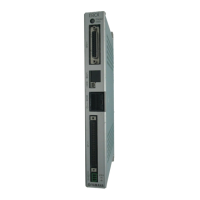11-8
11
COMMUNICATION WITH PC
11-5 Communication Command Description
11-5-1
Robot movements
(1)@ORG
@ORGN
This commands performs return-to-origin when the search method is selected as the origin detec-
tion method and outputs the machine reference value when return-to-origin is completed nor-
mally. When the mark method is selected, this command checks the return-to-origin status and
outputs the machine reference value if return-to-origin is complete but issues an error if incom-
plete.
Transmission example : @ORG c/r l/f ................................ Performs return-to-origin.
Response example 1 : OK c/r l/f
52% c/r l/f
OK c/r l/f
Response example 2 : NG c/r l/f ...................................... The robot is running.
Execute the command again
after stopping the robot.
31: running c/r l/f
Response example 3 : NG c/r I/f ...................................... Return-to-origin by the mark
method is not complete.
32: origin incomplete c/r l/f
n
NOTE
Once return-to-origin is performed after the robot cable and absolute battery are connected, there is no need to
repeat it even when the controller is turned off. (As an exception, return-to-origin becomes incomplete if the
absolute backup function is disabled or a parameter relating to the origin is changed. Return-to-origin must be
performed again in that case.)
c
CAUTION
When performing return-to-origin by the stroke-end detection method, do not interrupt the return-to-origin
operation while detecting the origin (while contacting the mechanical limit). Otherwise, the operation will stop
due to a controller overload alarm and the power will need to be turned on again.
c
CAUTION
If you must repeat return-to-origin using the stroke-end detection method, wait at least 5 seconds before
repeating it.
11-5 Communication Command Description

